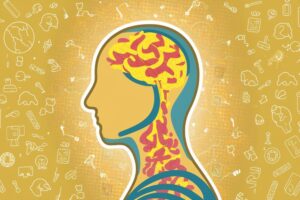What are the Hidden Symptoms of Generalized Anxiety Disorder?
Generalized Anxiety Disorder (GAD) is a mental condition that involves constant and overwhelming worry and anxiety about different prospects of life. While some symptoms of GAD, such as constant feelings of nervousness and tension, are well-known, there are also hidden symptoms that can go unnoticed or be mistaken for other issues.
In this article, we will delve into the less recognized manifestations of GAD, exploring the physical, cognitive, and emotional signs that individuals may experience. Understanding these hidden symptoms is crucial for accurate diagnosis, effective treatment, and improved quality of life for those affected by GAD.

Table of Contents
ToggleWhat is Generalized Anxiety Disorder (GAD)?
Generalized Anxiety Disorder (GAD) is a common mental health condition characterized by excessive and uncontrollable worry or anxiety about various aspects of life, such as work, relationships, and health.
Individuals with GAD often experience persistent feelings of restlessness, irritability, and difficulty concentrating, which can significantly impair their daily functioning. It is estimated that GAD affects approximately 3-5% of the population and is more commonly diagnosed in women than men.
The exact causes of GAD are not completely understood, but it is believed that a mix of genetic, biological, environmental, and psychological factors play a role in its development.
Individuals with a family history of anxiety disorders or a tendency to be anxious or overly sensitive may be at higher risk for developing GAD. Additionally, stressful life events, such as trauma or major life changes, can trigger the onset of GAD in susceptible individuals.
Diagnosing GAD typically involves a thorough evaluation by a mental health professional, such as a psychologist or psychiatrist, who will assess the individual’s symptoms, medical history, and any potential underlying factors contributing to the anxiety.
Treatment for GAD often involves a combination of psychotherapy, medication, and coping strategies to help individuals manage their symptoms and improve their quality of life.
Cognitive-behavioral therapy (CBT) has been shown to be particularly effective in helping individuals with GAD learn to challenge and change negative thought patterns that contribute to their anxiety.
In short, Generalized Anxiety Disorder is a debilitating mental health condition that can have a significant impact on an individual’s overall well-being and daily functioning.
Individuals with Generalized Anxiety Disorder (GAD) can improve their symptoms and lead fulfilling lives through accurate diagnosis and effective treatment.
It is important for individuals experiencing excessive worry or anxiety to seek help from a qualified mental health professional to receive the necessary support and guidance in overcoming their struggles with GAD.
Read more about “How to Identify Psychopathy through 7 Unique Eye Patterns?”
Distinguishing Between Normal Anxiety and GAD
Anxiety is a common emotional response to stress or perceived threats in our daily lives. However, there is a difference between normal anxiety that everyone experiences and Generalized Anxiety Disorder (GAD), which is a more severe and persistent form of anxiety.
Normal anxiety is typically short-lived and related to specific stressors, such as a job interview or upcoming exam. It usually goes away once the stressful situation has passed or the individual has learned to cope with it.
On the other hand, GAD is characterized by excessive worry and anxiety that is difficult to control and often persists for months or even years.

One key difference between normal anxiety and GAD is the intensity and duration of the symptoms. While it is normal to feel anxious before a significant event, such as a wedding or public speaking engagement, individuals with GAD may experience persistent and uncontrollable worry about a wide range of everyday concerns.
This chronic anxiety can interfere with their ability to function at work, school, or in social situations. Additionally, individuals with GAD may also experience physical symptoms such as muscle tension, fatigue, and difficulty sleeping, which are not typically present in cases of normal anxiety.
Another important distinction between normal anxiety and GAD is the impact on daily life and functioning. While normal anxiety may cause temporary distress or discomfort, individuals with GAD often have difficulty managing their symptoms and may struggle to carry out their usual activities.
They may avoid situations that trigger their anxiety, leading to social isolation and impairment in relationships. It is essential for individuals experiencing persistent and excessive worry to seek help from a healthcare professional, as GAD can be effectively treated with therapy, medication, or a combination of both.
Overall, recognizing the difference between normal anxiety and GAD is crucial for timely intervention and improved quality of life.
Read more about “Is Your Partner Self-Obsessed? Take This Narcissistic test”
Common Symptoms of Generalized Anxiety Disorder
Generalized Anxiety Disorder (GAD) is a common mental health condition characterized by excessive worrying and anxiety about a wide range of everyday issues. While it is normal to experience occasional anxiety, individuals with GAD often find it difficult to control their worries, leading to significant distress and impairment in their daily lives.
One of the most commonly recognized symptoms of GAD is persistent and excessive worry about a variety of different topics, such as work, health, relationships, and finances.
This worry is often disproportionate to the actual situation and can be difficult to control, even when the individual recognizes that their fears are unfounded.

In addition to excessive worry, individuals with GAD may also experience physical symptoms such as restlessness, muscle tension, irritability, and difficulty concentrating.
These symptoms can be debilitating and can affect a person’s ability to function effectively in their daily lives. Another hallmark symptom of GAD is difficulty relaxing or feeling constantly on edge, which can lead to difficulties with sleep and concentration.
Individuals with GAD may also experience physical symptoms such as fatigue, headaches, and stomach problems, which can further contribute to their overall distress and impairment.
Furthermore, individuals with GAD may also experience symptoms of anxiety that are not easily explained by specific triggers. This can include feelings of doom or impending disaster, feelings of being constantly on edge, and a sense of being easily overwhelmed by everyday tasks.
These symptoms can interfere with the individual’s ability to socialize, work, or engage in other activities that they once enjoyed. Individuals with GAD may also be more prone to developing other mental health conditions, such as depression or substance abuse disorders, as a result of their chronic anxiety.
In short, the symptoms of Generalized Anxiety Disorder can vary widely from person to person, but typically include excessive worry, physical symptoms, difficulty relaxing, and unexplained feelings of anxiety.
It is important for individuals with GAD to seek help from a mental health professional in order to receive an accurate diagnosis and appropriate treatment. With the right support and intervention, individuals with GAD can learn to manage their symptoms and lead fulfilling, productive lives.
Read more about “How Chronic Pain impacts Your Interpersonal Connections?”
Hidden Symptoms of Generalized Anxiety Disorder
1) Physical Symptoms of Generalized Anxiety Disorder (GAD)
People with GAD often experience a variety of physical symptoms that can significantly impact their daily functioning. One of the most common physical symptoms of GAD is muscle tension.
This can lead to physical discomfort, such as headaches, back pain, and tightness in the chest. Chronic muscle tension can also contribute to fatigue and sleep disturbances, further exacerbating the overall impact of the disorder on an individual’s health and well-being.
Another physical symptom of GAD is gastrointestinal issues, such as stomach pain, nausea, and digestive problems. The gut-brain connection is well established, and stress and anxiety can have a direct impact on gut health.
Individuals with GAD may also experience frequent urination or other urinary symptoms due to the body’s heightened state of arousal and stress response. These physical symptoms can be distressing and uncomfortable, adding to the overall burden of living with GAD.
Furthermore, individuals with GAD may also experience cardiovascular symptoms, such as rapid heartbeat, palpitations, and chest pain. These symptoms are a result of the body’s natural response to stress, which includes an increase in heart rate and blood pressure.
While these symptoms are typically harmless, they can be extremely distressing for individuals with GAD and may contribute to an increased sense of fear and worry.
Overall, the physical symptoms of GAD play a significant role in the overall experience of the disorder and can have a profound impact on an individual’s quality of life.
2) Cognitive Symptoms of Generalized Anxiety Disorder (GAD)
One of the key features of GAD is the presence of cognitive symptoms, which can significantly impact an individual’s daily functioning. Cognitive symptoms of GAD may include excessive rumination, difficulty concentrating, and feeling on edge or restless.
Individuals with GAD often experience excessive rumination, which involves constantly thinking about potential worst-case scenarios and worrying about things that may never happen.
This persistent rumination can lead to difficulty focusing on tasks or making decisions, as the mind is preoccupied with anxious thoughts.

Additionally, individuals with GAD may have difficulty concentrating on tasks as their mind is constantly racing with worry, making it challenging to stay focused and complete tasks efficiently.
Furthermore, individuals with GAD may experience a constant feeling of being on edge or restless, even in situations that are not inherently stressful. This heightened state of arousal can make it difficult for individuals to relax and may lead to physical symptoms such as muscle tension or restlessness.
These cognitive symptoms of GAD can significantly impair an individual’s quality of life and may interfere with their ability to function in various areas of life, such as work, relationships, and daily activities.
Therefore, it is crucial for individuals experiencing cognitive symptoms of GAD to seek professional help and treatment to manage their symptoms and improve their overall well-being.
3) Behavioral Symptoms of Generalized Anxiety Disorder (GAD)
One of the key behavioral symptoms of GAD is difficulty controlling worrying thoughts. Individuals with GAD often find themselves consumed by anxious thoughts that are difficult to turn off, even when there is no immediate threat or danger present. This persistent worry can interfere with daily activities and result in difficulty concentrating, making decisions, or completing tasks.
Another common behavioral symptom of GAD is avoidance of situations that may trigger anxiety. Individuals with GAD may go to great lengths to avoid situations or activities that they fear may provoke feelings of nervousness or worry.
This avoidance behavior can lead to social isolation, strained relationships, and a decrease in overall quality of life. Additionally, avoidance can reinforce the individual’s belief that the feared situation is dangerous, further perpetuating their anxiety.
In some cases, individuals with GAD may exhibit symptoms of restlessness or irritability. This can manifest as fidgeting, pacing, or difficulty sitting still, as well as a short temper or increased sensitivity to stressors.
These behavioral symptoms can be distressing for both the individual suffering from GAD and those around them. It is important for individuals with GAD to seek professional help in order to address these symptoms and develop coping strategies to manage their anxiety effectively.
4) Emotional Symptoms of Generalized Anxiety Disorder (GAD)
Individuals with GAD often experience a range of emotional symptoms that can significantly impact their daily functioning and quality of life.
One of the most prominent emotional symptoms of GAD is the constant feeling of dread or apprehension. This pervasive sense of unease can be overwhelming and can make it difficult for individuals to relax or enjoy activities they once found pleasurable.
Another emotional symptom of GAD is irritability and mood swings. Individuals with GAD may find themselves easily agitated or frustrated, even over minor issues.
This heightened emotional reactivity can strain relationships and lead to conflicts in both personal and professional settings.
Additionally, individuals with GAD may experience feelings of restlessness and an inability to concentrate. This can make it challenging to focus on tasks or make decisions, which can further exacerbate feelings of anxiety and stress.
Finally, individuals with GAD may also experience symptoms of depression, such as feelings of hopelessness or a lack of interest in activities. The constant worrying and fear associated with GAD can take a toll on one’s mental health, leading to a sense of helplessness and despair.
It is important for individuals experiencing emotional symptoms of GAD to seek professional help and support to manage their anxiety and improve their overall well-being.
By addressing these emotional symptoms, individuals with GAD can learn effective coping strategies and techniques to better manage their anxiety and lead a fulfilling life.
5) Psychological Symptoms of Generalized Anxiety Disorder (GAD)
Individuals with GAD often experience a range of psychological symptoms that can significantly impact their daily functioning. One common symptom is persistent fear or worry about a variety of things, such as work, health, finances, or relationships.
This excessive worry is often accompanied by difficulty controlling the worry, even when individuals recognize that their fears are irrational.
Another psychological symptom of GAD is difficulty concentrating or focusing on tasks. This can lead to decreased productivity and performance at work or in school.

Individuals with GAD may also experience irritability, restlessness, or difficulty sleeping due to their constant worry and anxiety. These symptoms can further exacerbate feelings of stress and overwhelm, creating a cycle of negative thoughts and emotions.
Additionally, individuals with GAD often exhibit physical symptoms such as muscle tension, fatigue, and gastrointestinal issues. These physical symptoms can further contribute to the psychological distress experienced by individuals with GAD.
It is important for individuals experiencing these psychological symptoms to seek professional help and support in order to effectively manage and cope with their anxiety.
Therapy, medication, and lifestyle changes can all be effective in reducing symptoms and improving overall well-being for individuals with GAD.
Read more about “From Panic to Peace: 10 Effective Methods to Calm Anxiety”
How Generalized Anxiety Disorder Impacts Our Daily Lives?
Generalized Anxiety Disorder (GAD) can have a significant impact on an individual’s daily life. Those suffering from GAD may experience excessive worry and fear about a wide range of situations, leading to difficulty in concentrating, making decisions, and performing daily tasks.

This chronic condition can also lead to physical symptoms such as muscle tension, fatigue, and insomnia, further affecting one’s overall functioning.
Individuals with GAD may find it challenging to maintain relationships, manage work responsibilities, or engage in social activities, as they may feel overwhelmed and preoccupied with their anxious thoughts.
Furthermore, GAD can also negatively impact one’s physical health. The constant state of stress and worry associated with this disorder can weaken the immune system, making individuals more vulnerable to illnesses.
Additionally, the strain of anxiety can take a toll on one’s cardiovascular health, contributing to an increased risk of hypertension and heart disease.
The constant cycle of anxiety and its physical manifestations can create a vicious cycle that further exacerbates the burden of GAD on an individual’s daily life.
Seeking appropriate treatment, including therapy and medication, is crucial in effectively managing GAD and minimizing its impact on daily functioning.
Impact of Generalized Anxiety Disorder on Relationships
Generalized Anxiety Disorder (GAD) can have a profound impact on relationships, both romantic and platonic. Individuals with GAD often experience excessive worrying and fear about a wide range of everyday situations, which can lead them to be overly dependent on their partner or friend for reassurance and support.
This can cause strains in the relationship, as the constant need for validation and reassurance can be overwhelming for the other person.

Additionally, individuals with GAD may be irritable, have difficulty focusing, and experience frequent mood swings, all of which can make it challenging to maintain healthy and fulfilling relationships.
It is essential for individuals with GAD to seek professional help and develop coping strategies to manage their symptoms and improve their relationships.
Conclusion:
In conclusion, the hidden symptoms of Generalized Anxiety Disorder can manifest in a multitude of ways that are not always easily recognizable. These symptoms may include insomnia, irritability, muscle tension, and difficulty concentrating.
It is important for healthcare professionals to be aware of these hidden signs in order to accurately diagnose and effectively treat patients suffering from this condition.
Additionally, individuals experiencing these symptoms may feel overwhelmed or misunderstood, making it crucial for them to seek support and guidance from medical professionals or mental health specialists.
By bringing awareness to these hidden symptoms, we can help individuals receive the appropriate care and support they need to manage their Generalized Anxiety Disorder effectively and improve their overall well-being.
FREQUENTLY ASKED QUESTIONS
1. What are some common misconceptions about Generalized Anxiety Disorder (GAD)?
One common misconception about Generalized Anxiety Disorder (GAD) is that it is simply a case of being overly worried or stressed. In reality, GAD is a complex mental health disorder characterized by persistent and excessive anxiety that can significantly impact a person’s daily life and functioning.
Another misconception is that individuals with GAD can simply “just relax” or “get over it.” This minimizes the severity of the disorder and undermines the need for professional treatment and support. Additionally, some may believe that those with GAD are just seeking attention or exaggerating their symptoms. However, it is essential to understand that GAD is a legitimate medical condition with physical, cognitive, and emotional symptoms that require appropriate intervention and care from trained professionals in order to effectively manage the disorder.
2. How can I differentiate between normal levels of anxiety and symptoms of GAD?
To differentiate between normal levels of anxiety and symptoms of GAD, it is important to consider the duration, intensity, and impact of the anxiety. Normal levels of anxiety are temporary and proportional to the perceived threat or stressor. In contrast, individuals with GAD experience constant and overwhelming anxiety that lasts for at least six months and interferes with daily activities such as work, school, or relationships.
Other key indicators of GAD include difficulty controlling worry, physical symptoms like muscle tension or fatigue, and intrusive negative thoughts. If you suspect you may have GAD, seeking guidance from a mental health professional can help provide an accurate diagnosis and appropriate treatment options.
3. Are there specific triggers or risk factors that contribute to the development of hidden symptoms in GAD?
Generalized Anxiety Disorder (GAD) is a complex mental health condition that can be difficult to diagnose due to its hidden symptoms. Specific risk factors contribute to the development of hidden symptoms in GAD, including genetic predisposition, environmental stressors, childhood trauma, and personality traits such as neuroticism.
Individuals with a family history of anxiety disorders are at an increased risk of developing GAD, as are those who experience high levels of chronic stress or trauma during childhood. Additionally, individuals with a tendency towards perfectionism or negative thinking patterns may be more susceptible to developing hidden symptoms of GAD. It is crucial for clinicians to consider these risk factors when assessing and treating individuals with GAD in order to provide effective interventions and support.
4. What are some practical strategies for managing the hidden symptoms of GAD in daily life?
Generalized Anxiety Disorder (GAD) can present with various hidden symptoms that can significantly impact an individual’s daily life. To manage these hidden symptoms effectively, it is essential to first identify triggers that cause anxiety and develop coping mechanisms.
One practical strategy for managing GAD symptoms is cognitive-behavioral therapy (CBT), which helps individuals recognize and challenge negative thought patterns. Additionally, relaxation techniques such as deep breathing exercises, mindfulness meditation, and progressive muscle relaxation can help reduce anxiety levels. Creating a structured daily routine that includes regular exercise, adequate sleep, healthy eating habits, and social support can also play a vital role in managing hidden symptoms of GAD.
It is important for individuals with GAD to seek professional help from therapists or counselors who specialize in treating anxiety disorders to learn more skills and strategies for managing their symptoms effectively.


